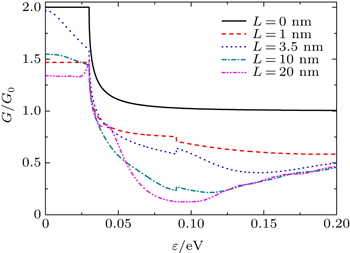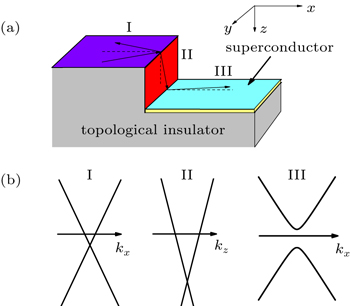† Corresponding author. E-mail:
Project supported by the National Natural Science Foundation of China (Grant Nos. 11204065 and 11474085) and the Natural Science Foundation of Hebei Province, China (Grant Nos. A2013205168 and A2014205005).
When two three-dimensional topological insulators (TIs) are brought close to each other with their surfaces aligned, the surfaces form a line junction. Similarly, three TI surfaces, not lying in a single plane, can form an atomic-scale nanostep junction. In this paper, Andreev reflection in a TI–TI–superconductor nanostep junction is investigated theoretically. Because of the existence of edge states along each line junction, the conductance for a nanostep junction is suppressed. When the incident energy (ɛ) of an electron is larger than the superconductor gap (Δ), the Andreev conductance in a step junction is less than unity while for a plane junction it is unity. The Andreev conductance is found to depend on the height of the step junction. The Andreev conductance exhibits oscillatory behavior as a function of the junction height with the amplitude of the oscillations remaining unchanged when ɛ = 0, but decreasing for ɛ = Δ, which is different from the case of the plane junction. The height of the step is therefore an important parameter for Andreev reflection in nanostep junctions, and plays a role similar to that of the delta potential barrier in normal metal–superconductor plane junctions.
Topological insulators (TIs) represent a new quantum state of matter.[1,2] With recent breakthroughs in two-dimensional (2D) and three-dimensional (3D) topological materials, a number of interesting and surprising phenomena have attracted much attention.[3–10] The electron velocity of the Dirac cone on the surface of a 3D TI[15], such as Bi2Te3 and Bi2Se3, depends on the properties of the material.[11,12] When two different 3D TIs are joined together, refraction phenomena due to the mismatch of electron velocities are expected at the junction,[13] and defects such as step-like imperfections may appear.[14] Quantum transport through a non-planar nanostep junction involving two different side surfaces of a 3D topological insulator has also been extensively investigated in recent years. In particular, it has been found that the conductance of a nanostep junction is suppressed in the large-energy limit by a factor of 1/3 as compared to the conductance of a similar junction between surfaces lying in a single plane.[15]
When one side of the nanostep junction is replaced with a superconductor (S), so-called Andreev reflection (AR) occurs due to the appearance of the superconducting energy gap Δ. For normal superconducting microconstriction contacts with a delta-function scattering potential at the N–S interface, the Andreev conductance amplitude is characterized by the parameter, Z, of the delta barrier.[16] In addition, it has been pointed out that for a ferromagnet–superconductor junction, the spin polarization of the conduction electrons in the ferromagnet can affect the AR.[17,18] At a normal-metal (ferromagnet)–superconductor interface in graphene, specular Andreev reflection appears.[19–22] As for the nanostep junction, because of the different velocities of the Dirac fermions on either side of TI–TI junction, edge states appear along the step junction.[23] The velocity of the edge states is less than the velocities of the incoming plane waves, and the spins of the edge states have a nonzero component in the direction perpendicular to the surfaces.
Motivated by these novel phenomena,in this paper, we investigate Andreev reflection through a topological insulator-superconductor nanostep junction,consisting of a horizontal TI, a vertical TI, and a horizontal superconductor with emphasis on effects due to the step height.
The model of the topological insulator–superconductor (N1N2S) step junction we have considered is shown in Fig.
In region I, the effective surface Hamiltonian describing the carriers in the x–y plane of the topological insulator is given by 


Similarly, the carriers in the y–z plane of the topological insulator in region II are described by the effective Hamiltonian 


Since superconductivity couples the electron and hole wave functions, the Hamiltonian for the surface states on the topological superconductor in region III acting on the Nambu basis



The eigenstates in region I can be written as



Analogously, in region II, the eigenstates for the electrons and holes are






In the region III, the electron (hole)-like quasiparticles are both mixtures of electrons and holes, and the transmitted wave functions have the form of




At each interface, we need to consider two kinds of scattering: (i) reflection as an electron and (ii) Andreev reflection as a hole. The total wave function in the different regions may then be written as 

By taking into account the boundary conditions ΨI(x = 0) = ΨII(z = 0) and ΨII(z = L) = ΨIII(x = 0), the normalized Andreev conductance G/G0 at zero temperature can be calculated using the expression,


In our calculations, typical parameter values for the 3D topological insulator Bi2Se3 were used: A1 = 2.2 eV·Å, A2 = 4.1 eV·Å,



We first investigate the Andreev conductance as a function of the incident electron energy ɛ for different heights of the step (see Fig. 
 | Fig. 2. The Andreev conductance in N1N2S junction as a function of incident energy ɛ with different junction height L. |
We note that in Fig. 
The conductance for a relatively high N1N2S step junction is shown in Fig. 

We next study the behavior of the conductance for two special values of the energy: ɛ = 0 and ɛ = Δ. For ɛ = 0, the analytical expressions for the scattering coefficients re and rh can be written as


 | Fig. 4. The Andreev conductance in N1N2S junction as a function of the junction height L with different incident energies, (a) ɛ = 0 and (b) ɛ = Δ, respectively. |
The Andreev conductance for ɛ = Δ is shown in Fig.
In summary, we have studied Andreev reflection in a TI–TI–superconductor nanostep junction. Due to the edge states that lie along the boundaries between the different regions of the step junction, the conductance for a nanostep junction is suppressed. It is interesting to note that as a function of the step height the Andreev conductance presents an oscillatory behavior and that the amplitude of the conductance decreases when ɛ = Δ. However, for ɛ = 0 the amplitude of the oscillation does not change as a function of L, which is different from the case of a single planar junction. We hope that the suppression of the Andreev conductance discussed here can be measured using angle-resolved photoemission spectroscopy and/or electron tunneling with a STM tip placed close to the TI–S nanostep junction.
| 1 | |
| 2 | |
| 3 | |
| 4 | |
| 5 | |
| 6 | |
| 7 | |
| 8 | |
| 9 | |
| 10 | |
| 11 | |
| 12 | |
| 13 | |
| 14 | |
| 15 | |
| 16 | |
| 17 | |
| 18 | |
| 19 | |
| 20 | |
| 21 | |
| 22 | |
| 23 | |
| 24 |




